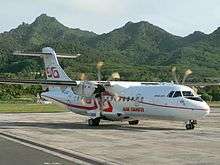Air Tahiti
|
| |||||||
| |||||||
| Founded | 1987 | ||||||
|---|---|---|---|---|---|---|---|
| Hubs | Faaa International | ||||||
| Fleet size | 15 | ||||||
| Destinations | 48 | ||||||
| Headquarters | Faaa, Tahiti, French Polynesia, France | ||||||
| Key people | Joël ALLAIN (CEO), Manate VIVISH (General Manager) | ||||||
| Website | https://www.airtahiti.com | ||||||
Air Tahiti is a French airline company which operates in French Polynesia, France. Its principal base is Faa'a International Airport.
Destinations
Air Tahiti covers a network of 47 islands in French Polynesia.
Society Islands
Tuamotu Archipelago
- Ahe
- Aratika
- Arutua
- Faaite
- Fakarava
- Katiu
- Kauehi
- Kaukura
- Manihi
- Mataiva
- Niau
- Rangiroa
- Takapoto
- Takaroa
- Tikehau
East Tuamotu-Gambier archipelago
- Anaa
- Fangatau
- Hao
- Hikueru
- Mangareva /(Gambier)
- Makemo
- Napuka
- Nukutavake
- Pukarua
- Raroia
- Reao
- Tatakoto
- Tureia
- Vahitahi
Marquesas archipelago
Austral archipelago
Marquesas archipelago

Tuamotu archipelago
Fleet
As of September 2018, the Air Tahiti fleet consists of:[1]
| Aircraft | Total | Passengers (Economy) |
|---|---|---|
| ATR 42-600 | 2 | 48 |
| ATR 72-600 | 7 | 68 |
| Beechcraft King Air B200 | 3 | 8 |
| de Havilland Canada DHC-6 Twin Otter (DHC-6-300) | 2 | 19 |
| Total | 14 |
Company history
The story of Air Tahiti is closely linked to the history of aviation in Polynesia.
The debut by seaplane
Far away from continents, Polynesia was late in developing air routes. It was only during the Second World War that aviation took off in earnest with the construction of the first runway in 1943, in Bora Bora, by U.S. forces. In the aftermath of the attack on Pearl Harbor, the Americans intended to protect and supply routes between the U.S. coast and the southwest Pacific.
Regular commercial air service between the islands started in 1950 at the initiative of a handful of entrepreneurs who created the company Air Tahiti. The flights were operated by a 7-seater seaplane, a Grumman Widgeon J-4F. With such low capacity, the need for a second aircraft was quickly apparent.
In 1951, the French Ministry for the Overseas purchased on behalf of the Territory a Grumman Mallard amphibian aircraft. Gradually, Air Tahiti spread its wings to all the islands of French Polynesia. On June 25, 1953, the first landing in the Gambier archipelago was achieved. In October 1953, the first flight to the Marquesas islands took place with a sea-landing at Taiohae / Nuku Hiva.
In July 1953, TAI (Transports Aériens Intercontinentaux - International Air Transports)' a commercial exploitation of RAI (Régie Aérienne Interinsulaire – Inter-Island Aviation Board), asserted its rights in the mutual allocation of local transports, under an agreement with Air France.
The Territory withdrew the Mallard licence from Air Tahiti in favour of TAI. The Air Tahiti brand then disappeared. RAI operated for the Department of Public Works and Transport. It acquired two Consolidated PBY Catalina seaplanes to expand links between the islands of French Polynesia. These aircraft with orange livery received a F-OA registration restricted to aircraft operated overseas.
Gradually, the network continued to expand. In 1955, the Austral archipelagos inaugurated seaplane service with the opening of routes to Tubuai and Raivavae. In 1958, the "Régie" became "Réseau" (Inter-Island Aviation Network) with Réseau Aérien Interinsulaire (RAI) operating Douglas DC-4 propliners and Short Sandringham "Bermuda" flying boats during the early 1960s.[2]
The development of runways
Although seaplanes would seem appropriate to the insular context, it is difficult to find suitable large bodies of water, unhindered and protected from sea swell. Therefore, it became necessary to quickly develop runways and airstrips.
With the opening of the Tahiti Faa'a International Airport in Papeete in 1960, Tahiti could host international commercial jetliner flights. Thereafter, a vast construction program of runways was launched by the French Government over the whole of French Polynesia. As a result, four runways were built in the 1960s and 27 in the following decade.
Air Polynesia
In 1970, RAI became Air Polynesia, a subsidiary of UTA that was also known as Air Polynésie.[3] Nicknamed "Air Po" by Polynesians, the company asserted more of its Polynesian identity and implemented regular services throughout French Polynesia and especially to the more remote islands. The airline operated Douglas DC-4 propliners, Short Sandringham "Bermuda" flying boats and de Havilland Canada DHC-6 Twin Otter turboprops before introducing Fokker F27 turboprops.[4]
Air Tahiti
In 1986, the former UTA (by then absorbed by Air France) sold Air Polynesia shares to local investors. This assignment gave birth in 1986 to Air Tahiti as we know it today. The new company, wanting to modernize, in 1987 acquired its first ATR 42 regional turboprop aircraft, marking the beginning of a long collaboration with the aircraft manufacturer ATR.
Accidents
Air Tahiti has experienced one accident since 1987.
On April 18, 1991, approaching the airport of "Nuku A Taha/ Terre Déserte" in Nuku Hiva, Marquesas, following an engine failure, the Dornier 228 commuter turboprop (F-OHAB) flying the route attempted to land near the coast. Ten passengers out of twenty in the aircraft were killed.
References
- ↑ https://www.airtahiti.com/fleet
- ↑ http://www.timetableimages.com, April 1, 1963 Transports Aeriens Intercontinentaux (TAI) system timetable, RAI flight schedules
- ↑ http://www.timetableimages.com, Sept. 30, 1970 Air Polynesie system timetable
- ↑ http://www.timetableimages.com, Air Polynesie system timetables
External links
| Wikimedia Commons has media related to Air Tahiti. |